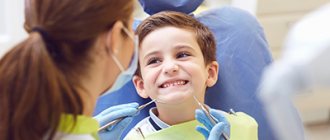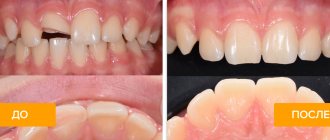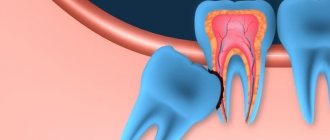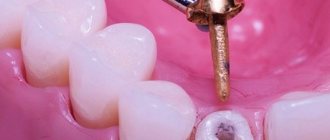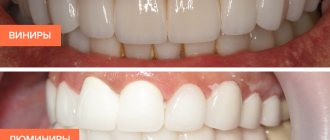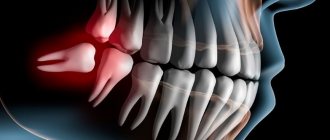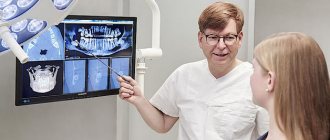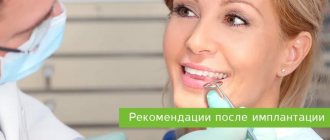Causes of dislocation Symptoms Classification Possible complications Diagnosis Treatment and prognosis If the tooth cannot be saved
Tooth dislocation is a dental injury in which an incisor or canine is displaced in the alveolus (socket) in a lateral or vertical position due to mechanical impact. Due to the peculiarities of the anatomical structure, the upper incisors and canines are more often exposed to such damage. Anatomically, each dental unit consists of a crown and a root. The coronal part is located above the gum, the root is in the jaw bone (alveolus, socket).
Between the alveolus and the root there is a periodontal ligament, consisting of connective tissue fibers. Intertwined with the alveolus and root cement, the periodontium holds the root in the jaw. The combination of 3 elements (alveolus, periodontium, cementum) is called the ligamentous apparatus of the tooth
. It can be injured due to a blow, biting on a hard product or object, resulting in dislocation or subluxation of the root, its disposition in the dentition. Traumatic tooth dislocation in the lower jaw is less common than in the upper jaw.
A timely visit to the doctor makes it possible to save the injured incisor and avoid removal. According to the severity of the injury, adequate treatment is carried out, including immobilization of the dental unit by fixing it to adjacent teeth. Even if the incisor has fallen out, but the root and crown are preserved, with prompt treatment it is possible to restore the tooth using replantation.
Symptoms
- Disposition of a dental unit in a row (from slight mobility to loss);
- severe pain in the area of injury;
- violation of chewing and speech functions;
- swelling, redness, increased sensitivity of the gums;
- Difficulty closing the jaws.
Dislocation of a baby tooth is one of the most common injuries in children under 3 years of age. The most threatening is an impacted tooth dislocation, since in this case the bone bottom may be destroyed, which will interfere with the formation of a permanent unit. Signs of tooth dislocation in children are similar to those in adults.
Causes, diagnosis of tooth dislocation
In children and adults, the causes of the disorder are similar. This:
- Swipe. Mechanical injury can easily occur when falling.
- Biting on a hard foreign body or chewing too hard food. The classic is cracking a nut shell.
- Incorrect behavior. Attempts to use teeth as a tool. A common example is opening a bottle with a metal cap.
- An unsuccessfully removed adjacent tooth with a non-standardly located root system.
There are different types of injuries:
- Spicy. Instant, strong action.
- Chronic. Long-term weak influence of factors. For example, biting duct tape during work.
Diagnosis of tooth dislocation is not difficult - a visual examination by a specialist, confirmed by an x-ray, is required. Complications are possible - destruction of the dental floor, a bone crack is not excluded. To assess the situation and specify the diagnosis, an objective examination is necessary based on computed tomography.
Classification
- Incomplete
tooth dislocation - the crown part is displaced in different directions or rotated around an axis, the incisor is movable, but is held in the socket. The dental unit responds to touch with sharp pain. The gum separates from the hard tissues of the crown, bleeds, turns red, and swells. Such an injury can be complicated by destruction of the pulp chamber (internal cavity with a neurovascular bundle), atypical changes in the root part (shortening, curvature). - Complete dislocation
of the tooth - the crown part with the root has completely fallen out of the socket, the gum is separated, swollen, and has acquired a bluish tint. There was a bleeding hole where the incisor was located. This type of injury occurs more often with primary teeth because they do not have a developed root system. - Impacted
tooth dislocation - implies a shift of the dental unit towards the jaw. The coronal part is completely or significantly immersed in the gingival tissue (visually, the height of the visible part decreases). The injury may be accompanied by root splitting, destruction of the jaw bone, damage to the pulp, and rupture of blood vessels.
Causes of dislocations
Dislocations occur due to strong and sudden mechanical impact. As a result, the tooth is displaced relative to the alveolus, and the connective tissue surrounding the tooth and its neurovascular bundle are damaged. The reason may be:
- blow to the tooth;
- biting hard food;
- contact with a tooth of a hard foreign body, such as a stone, while chewing food;
- bad habits, such as opening bottles with teeth, cracking nuts;
- inaccurate tooth extraction, leading to dislocation of the adjacent one [1, 2].
The incidence of dental injuries due to other dental diseases is increasing every year.
In this case, the frontal teeth, compared to the distant molars, are subject to injury more often due to lack of protection. It is curious that this problem is more often faced by men who often get into fights, engage in aggressive sports (boxing, martial arts), and practice extreme types of recreation. Naumovich Yu. Ya., Ph.D., orthodontist [3]
Diagnostics
Only a dentist can differentiate a root dislocation from a fracture. Not only the incisor is damaged, but also the periodontal tissues. A crack may form in the jaw bone. Comprehensive diagnostics includes:
- Orthopantomogram;
- sighting shot of the incisor;
- CT;
- three-dimensional scanning of the maxillofacial area.
The dentist makes a diagnosis based on examination, complaints, and X-ray results. The doctor analyzes the clinical picture and assesses the condition of the jaw bone in the injured area.
Prevention of dislocations
Most injuries can be prevented by following these precautions:
- Think about the organization of the interior. Creating a non-traumatic environment is especially important for young children who have recently started walking, but adults also get dislocated teeth at home. There should be no protrusions or dangerous sharp corners in the room that could cause you to trip. Sufficient lighting must be provided in all areas of the space.
- Keep an eye on the child. Children of preschool and primary school age should not be left unattended during active games with peers, even on specially equipped playgrounds.
- Use of protective equipment when playing sports - masks, helmets, mouthguards, as well as comfortable shoes that prevent falls.
- Elimination of bad habits that lead to dislocations - chewing hard objects, opening bottles with teeth, etc. [3, 4].
Treating a dislocated tooth is difficult. Often it is not possible to save a tooth, and even with a favorable outcome of treatment, its service life is reduced. This is why prevention rules play such an important role. Simple safety precautions help prevent troubles and preserve the integrity of your teeth for life.
List of sources:
- Cherchenko N. N. Dislocations and fractures of teeth. Fractures of the alveolar process: educational and methodological manual. Minsk: BSMU, 2013. // URL: https://rep.bsmu.by/bitstream/handle/BSMU/1742/%D0%92%D1%8B%D0%B2%D0%B8%D1%85%D0 %B8%20%D0%B8%20%D0%BF%D0%B5%D1%80%D0%B5%D0%BB%D0%BE%D0%BC%D1%8B%20%D0%B7%D1 %83%D0%B1%D0%BE%D0%B2.pdf?sequence=3&isAllowed=y (accessed 08/18/2021).
- Negametzyanov N. N., Aldasheva M. A., Zhanabaeva G. B. Clinical protocol for the diagnosis and treatment of dental injuries // URL: https://www.rcrz.kz/docs/clinic_protocol/2016/2%D0%BF% D0%B3/%D0%9F%D0%B5%D0%B4%D0%B8%D0%B0%D1%82%D1%80%D0%B8%D1%8F/%D0%A1%D1%82% D0%BE%D0%BC%D0%B0%D1%82%D0%BE%D0%BB%D0%BE%D0%B3%D0%B8%D1%8F/2%20%D0%9F%D0% BE%D1%82%D0%B5%D1%80%D1%8F%20%D0%B7%D1%83%D0%B1%D0%BE%D0%B2%20%D0%B2%D1%81% D0%BB%D0%B5%D0%B4%D1%81%D1%82%D0%B2%D0%B8%D0%B5%20%D1%82%D1%80%D0%B0%D0%B2% D0%BC%D1%8B%20%D1%83%20%D0%B4%D0%B5%D1%82%D0%B5%D0%B9.pdf (date of access: 08/18/2021).
- Naumovich Yu. Ya., Ph.D., dentist-orthodontist, article “Dental injuries” // URL: https://www.roden.by/bolezni/travmy-zubov/ (access date: 08/18/2021 .).
- Morozova N.V., Vasmanova E.V., Vinnichenko A.V., Golochalova N.V., Khromenkova K.V., Ivankina E.O. Dental injuries in children: a textbook. M.: FGBOU DPO RMANPO, 2022. // URL: https://irbis.rmapo.ru/UploadsFilesForIrbis/30f79a8db3798e14e3481477e130db73.pdf (access date: 08/18/2021).
Treatment and prognosis
The doctor determines how to treat a tooth after a dislocation based on the type of traumatic injury. The decision on the treatment method is made according to the condition of the jaw bone and the detected degree of displacement.
- In case of pronounced displacement,
the dentist pulls the incisor with special forceps to its previous position and fixes it with a splinting device. - If the tooth is slightly misaligned,
splinting is not always required; the unit often recovers on its own.
Partial dislocation of the front teeth involves the following stages of treatment:
- Reposition (the incisor is returned to the correct position);
- fixation with a splinting structure (splints, staples, mouth guards, etc.);
- depulpation and filling of dental canals (if the pulp is dead).
If an injury occurs, you need to seek help from a dentist as quickly as possible. Even with complete dislocation in the first 30-40 minutes
replantation can be performed while preserving the dental unit. During the procedure, the doctor implants the dislocated tooth into its own alveolar bed and fixes it with a splinting device. The wearing time of the splint is 4-6 weeks. If the pulp is damaged, it is first removed with further filling of the canals, then the cutter is inserted into place under anesthesia and secured with a splint.
Treatment of complete dislocation of teeth by replantation is applicable only to permanent units without cracks, chips in the enamel, or root damage. Replantation with preparation takes about 40-60 minutes, the replant healing period is 2-3 weeks, sometimes more.
Symptoms and diagnosis
The clinical picture depends on the type of dislocation.
- In case of incomplete dislocation, pain occurs immediately after the injury, which intensifies when the tooth and gum touch. The tooth becomes mobile. The gums around it may be swollen or even torn, and sometimes blood is visible at the junction of the tooth and gum. On a radiograph, the tooth root appears short due to its inclination [1, 3, 4].
- With complete dislocation, pain and bleeding of the gums in the tooth area appears. The tooth itself is very mobile, since it is held only by the circular ligament. Often, a tooth falls out completely, and only a socket filled with a blood clot remains [2, 4].
- With an impacted dislocation, the pain is insignificant, including when pressed. In most cases, tooth mobility is not observed, but its “shortening” is noticeable. The gums in the dislocation area bleed. The doctor sees on the radiograph a narrowing or even complete absence of the periodontal gap between the root and the alveolus - due to the fact that a wider part of the root is immersed in the bone tissue [1, 2].
Questions and answers
If a tooth falls out due to injury, can you put it back in place yourself at home?
This procedure should not be performed at home. Such attempts will not give the desired result, but will lead to infection. You should contact your dentist immediately. Replantation is possible only in exceptional cases. In other cases, the patient will be offered prosthetics (bridge construction) or implant installation.
What diagnostics are needed for dislocations?
The dentist prescribes a computed tomography scan of the jaws - a three-dimensional image that will show whether there is damage to the alveolar process, roots, or whether there are changes in the periodontium. Computed tomography will help determine an accurate diagnosis and choose the right treatment tactics.
What are the complications of a dislocation?
If you do not consult a dentist in time, serious consequences of this injury will occur. Among the complications are inflammatory ones: pulpitis, periodontitis, periostitis, abscess. Children often experience a stop in the development of the permanent tooth germ. To avoid these complications, you should immediately contact your dentist.
How to protect yourself from dislocations when playing sports?
For this purpose, sports protective mouth guards are manufactured. You should contact an orthopedic dentist. Mouthguards are made individually for each patient based on casts of the jaws. Therefore, they are conveniently fixed on the jaws, do not create discomfort and reliably perform their protective function.
INJURY OF MILK TEETH. What to do?
Baby teeth can be injured just like permanent teeth, but first aid and treatment tactics are different.
An important feature that determines “what to do” is the proximity of the roots of baby teeth to the rudiments of permanent teeth. Therefore, in case of injury, the main concern is the preservation of future (permanent) teeth.
Nevertheless, if it is possible to preserve baby teeth without harm to permanent teeth, the dentist will act this way. The goal of treatment is to organize the healing process of the periodontium (tissues surrounding the tooth) and the pulp of the baby tooth, provided that this does not harm the formation of permanent teeth.
TOOTH FRACTURE. What to do?
As we wrote above, the following injuries include tooth fractures:
- chipped piece of enamel
- chipping of the crown within the dentin without damage to the dental pulp
- fracture of the tooth crown with damage to the pulp (blood is visible at the fracture site)
- tooth root fracture
Root fractures can be of more complex types:
In all these cases the recommendation is the same:
- If possible, find all the broken tooth fragments and place them in water
- No emergency visit to the dentist is required; make an appointment this day or the next .
Dental injuries
Thus, depending on the duration of exposure to the causative factors, dental injuries can be acute or chronic. Depending on the time of occurrence, injuries to temporary and permanent teeth are distinguished. In descending order of frequency, among injuries to primary teeth there are tooth dislocations, less often - fractures of roots and crowns; Among injuries to permanent teeth, crown fractures are the most common, followed by dislocations and bruises of teeth, and root fractures.
According to the WHO classification, dental injuries are divided into 8 classes:
- Class I
- tooth bruises, accompanied by minor violations of the integrity of their structure (enamel cracks) - Class II
- uncomplicated fractures of the coronal part of the tooth - Class III
- complicated fractures of the crown of the tooth - Class IV
- complete fractures of dental crowns - Class V
- longitudinal crown-root fractures - Class VI
– dental root fractures - Class VII
– incomplete dislocations (subluxations) of teeth - Class VIII
- complete avulsions of teeth
Depending on the completeness of the formation of the root system, types of dental injuries are distinguished in some classes:
- traumatic damage to a tooth with incomplete root growth
- traumatic damage to a tooth with incomplete formation of the root apex
- traumatic damage to a tooth with a fully formed root system.
In addition to “pure” dental injuries, there are combined injuries that combine two or more forms: a combination of incomplete dislocation with a fracture of the crown or root of a tooth, a simultaneous combination of a fracture of the dental crown and root, a combination of impacted dislocation with a fracture of the crown/root of a tooth, etc.
Bruised tooth
Symptoms of tooth bruise
A tooth bruise is a closed mechanical injury to a tooth that does not lead to disruption of its anatomical integrity. When a tooth is bruised, damage to periodontal tissue is observed (ischemia, tear or rupture of fibers). In case of complete rupture of the neurovascular bundle, hemorrhage occurs in the pulp chamber and death of the tooth pulp.
This type of tooth injury is manifested by a constant aching toothache, which intensifies when biting and percussing the tooth. Due to swelling of the periodontal tissues, the patient has a feeling of the tooth coming out of the socket, and its moderate mobility may be determined. A consequence of hemorrhage into the tooth pulp may be a pink coloration of the crown.
Diagnosis and treatment of tooth bruises
A bruise is diagnosed based on anamnesis (fact of dental trauma), clinical and objective signs (pain on percussion, darkening of the crown, etc.) and instrumental data. Radiography allows you to see the expansion of the periodontal fissure and exclude a fracture of the tooth root. In order to monitor the vitality of the pulp after a tooth injury, it is necessary to repeat the electroodontodiagnosis over time after 3-4 weeks.
Treatment of this injury involves mechanical sparing of the damaged tooth until the pain subsides. It is recommended to exclude solid foods from the diet and chewing on the affected side. To prevent contact with teeth by antagonists, the cutting edges or cusps are ground off. In order to relieve inflammation, the dentist may prescribe medication and physical therapy to the patient. If it is established that the pulp has died, its extirpation is performed, followed by filling the canals.
Tooth luxation
Symptoms of tooth dislocation
Tooth dislocation involves a type of injury in which the tooth partially or completely loses its connection with the socket. Incomplete tooth luxation (extrusion) occurs as a result of tear or rupture of periodontal fibers and damage to the alveolar wall. This type of injury is characterized by pain, mobility and changes in the position of the tooth, and impaired chewing function. In case of incomplete dislocation, the crown of the tooth moves in the vestibular, oral, distal or other directions, and the root of the tooth moves in the opposite direction. Due to a violation of the integrity of periodontal tissues, pathological, bleeding periodontal pockets can form. Incomplete dislocations of teeth can be complicated by the formation of dental granulomas and root cysts, chronic periodontitis, impaired development of the tooth root, expansion or obliteration of dental canals.
With complete dislocation (avulsion, traumatic tooth extraction), all periodontal tissues and the circular ligament of the tooth are ruptured, which is accompanied by its loss from the socket. More often, complete dislocation of the central incisors of the upper jaw is observed. A dental examination reveals the absence of a tooth in the dentition, the presence in its place of an empty socket with a fresh blood clot or signs of ongoing bleeding. In case of dental injuries accompanied by their dislocation, there are often bruises and wounds of the soft tissues of the face, lips, and oral mucosa.
Impacted tooth dislocation (intrusion) is accompanied by the penetration of the tooth root into the thickness of the bone of the alveolar process and the immersion of the coronal part of the tooth into the socket. With this type of injury, the crown becomes shorter than the surrounding teeth, pain and alveolar bleeding occur.
Diagnosis and treatment of tooth dislocation
These types of dental injuries are diagnosed based on clinical data (displacement or absence of a tooth) and radiological signs. Data from an X-ray or radiovisiographic examination make it possible to clarify the position of the tooth and the condition of the alveolar bone. The vitality of the pulp in case of dental trauma is determined using EDI.
In case of incomplete dislocation, therapy aimed at preserving the tooth is indicated: reposition of the dislocated tooth with its fixation using mouth guards, splints, and wire splinting structures. A gentle regimen, anti-inflammatory and antibacterial therapy is prescribed with a re-examination after 1 month. If the pulp dies, endodontic treatment is performed.
Treatment for complete dislocation may include prosthetics or dental implantation; in some cases - replantation of the tooth - returning it to the socket, followed by splinting and monitoring of healing.
In case of impacted dislocations, it is possible to perform a one-stage reposition of the tooth under local anesthesia with its subsequent immobilization; long-term reposition (orthodontic treatment); tooth extraction and its replacement with a prosthesis; tooth extraction with its replantation.
Tooth fracture
Symptoms of tooth fracture
This type of dental trauma (tooth fracture) includes fractures of the crown part of the tooth within the enamel or dentin, crown fracture, and root fractures.
Fractures of the crowns are clinically manifested by a violation of the shape of the tooth, an aesthetic defect, and pain in the tooth. The tooth remains immobile. The sharp edges of a tooth crown defect can injure the mucous membrane of the mouth, tongue and lips. With this type of tooth trauma, the development of acute traumatic pulpitis or periodontitis is possible.
Fractures of tooth roots can be oblique, transverse, longitudinal, or comminuted; with localization in the lower, middle or upper third; with or without displacement of fragments. This type of injury is accompanied by pain when biting and percussing the tooth, and mobility of the crown of varying severity.
Diagnosis and treatment of tooth fracture
Fractures of the crown of a tooth are diagnosed through a dental examination. To confirm/exclude a tooth root fracture, targeted radiography is indicated; to assess the condition of the pulp - electroodontometry.
Treatment of a crown fracture consists of restoring the crown part of the tooth with composite materials or a stump insert and a permanent crown. In case of a complicated tooth fracture, treatment of pulpitis followed by tooth restoration is indicated. For root fractures, treatment options may include tooth extraction, endodontic root treatment followed by tooth post placement.
